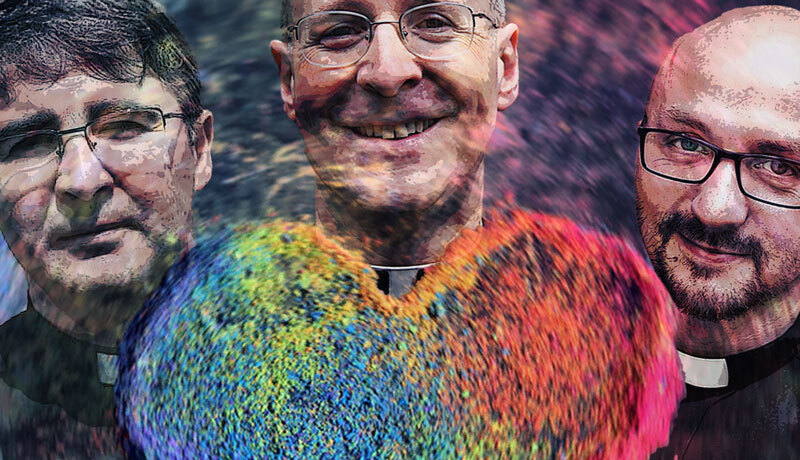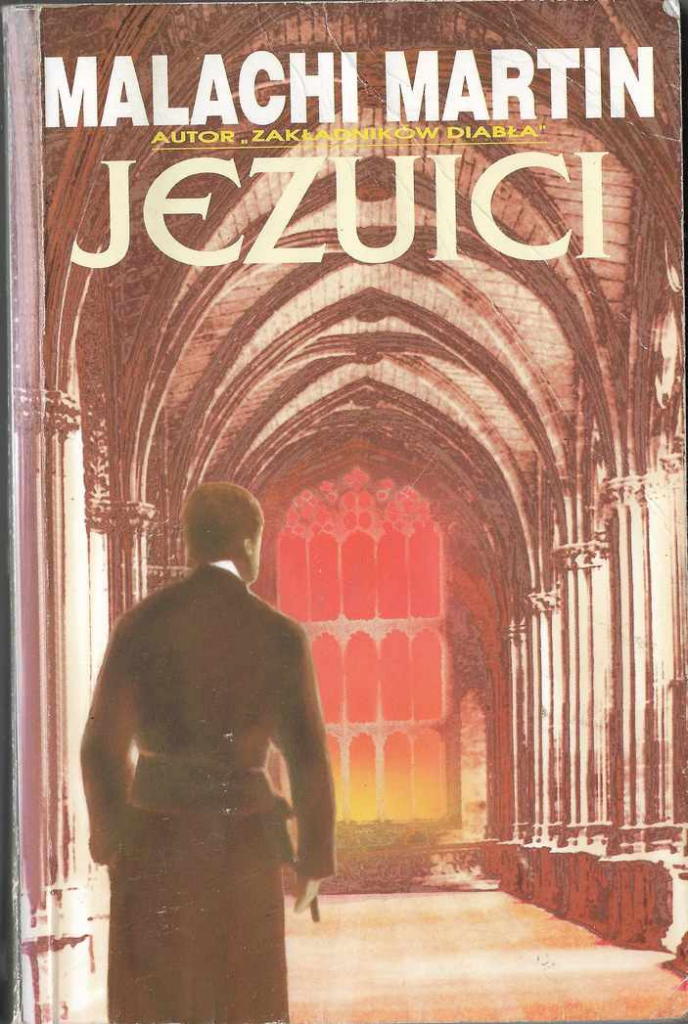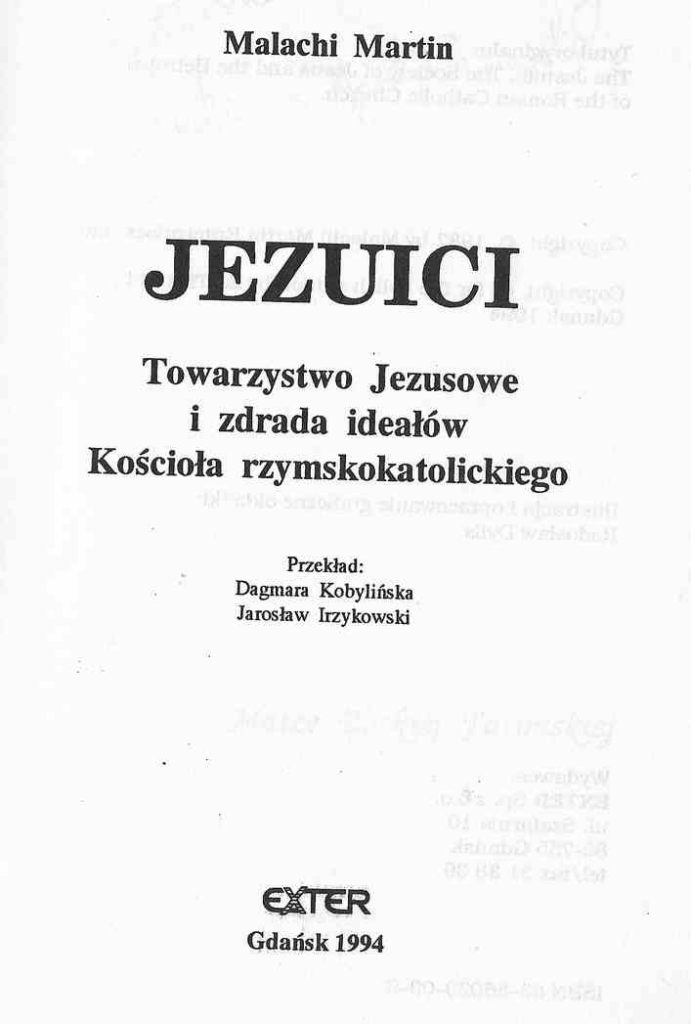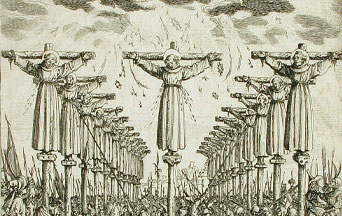Upadek jezuitów. Czy Towarzystwo da Kościołowi jeszcze coś dobrego?

Towarzystwo Jezusowe jest w kryzysie – tak głębokim, że nie wiadomo, czy jeszcze się z niego podniesie. Skrót „SJ” zaczyna się kojarzyć nie z oddaniem Chrystusowi, ale z prowokacją i intelektualnymi wybiegami, które mają uzasadniać liberalizm. Kto wie: może jezuici już bezpowrotnie stracili szansę bycia narzędziem w rękach Boga.
Jezuitów jest na świecie kilkanaście tysięcy, w Polsce kilkuset. Wszystkie uogólnienia trzeba dlatego traktować z pewnym dystansem. Towarzystwo Jezusowe zawsze cieszyło się znaczną liczbą doskonałych kapłanów i tak jest na pewno również dzisiaj. Niestety, nie sposób zaprzeczyć, że o ile św. Ignacego Loyolę można z powodzeniem nazywać zarówno mistrzem duchowości jak i walecznym rycerzem sprawy katolickiej, to z trudem można byłoby zastosować takie określenia do typowego jezuity naszych czasów. Staje się to tym bardziej prawdziwe, jeżeli przyjrzeć się znanym członkom Towarzystwa. Zarówno na świecie jak i w naszym kraju jezuici celują we wzbudzaniu niezdrowej sensacji, lubując się w prowokacjach i przekraczaniu granic.
Podam kilka wymownych przykładów, zaczynając od Polski.
Ojciec Grzegorz Kramer. Tylko w ostatnich miesiącach wywołał dwa skandale, publikując wizerunek Matki Bożej z elementami symbolicznej dla ruchu LGBT tęczy, a później Zbawiciela ubranego w bluzę z nauczycielem fałszywej religii, Siddharthą Gautamą (tzw. budda). O jego wcześniejszej prowokacyjnej aktywności nie ma już nawet co mówić, każdy pamięta, jak – na przykład – „dziękował za odwagę” Piotrowi S., który popełnił samobójstwo z przyczyn politycznych, dla walki z PiS…
Ojciec Wacław Oszajca. Niedawno zaatakował procesje Bożego Ciała, oskarżając pobożność Bożocielną o ciemnotę, fanatyzm, doktrynerstwo i nietolerancję, a katolików w nich uczestniczących lżąc jako ludzi, którzy w oczach postronnych mogą uchodzić za mających skłonności kanibalistyczne. Później oskarżył katolicką egzegezę o fałszywą ocenę zdrady św. Piotra, bo Apostoł, wypierając się Chrystusa Pana, miał mieć przecież rację.
Ojciec Wojciech Żmudziński. Ogłosił, że Matka Boża nie mogła interweniować w Bitwie Warszawskiej, a to ze względu na, między innymi, dobrostan ruskich sołdatów, wobec czego na pewno nie interweniowała, a ci, którzy twierdzą, że było inaczej, powtarzają nieewangeliczną i brudną endecką propagandę. Po ogłoszeniu deklaracji Fiducia supplicans o błogosławieniu par LGBT jej krytyków przyrównał z kolei do ludzi błogosławiących „czołgi i armaty”, sugerując, że są to ludzie z przepowiedni Pana Jezusa, którzy zabijając Jego uczniów sądzą, że oddają cześć Bogu.
Ojciec Jacek Prusak. Tak dużo razy powtarzał za niemieckimi progresistami, że św. Paweł nigdy nie potępił homoseksualizmu, że chyba sam w to uwierzył i uznał za dowiedzione, bo ostatnio przestał o tym mówić. Ogranicza się do stwierdzania, że ludzie bez względu na orientację seksualną mogą „kochać w celibacie”, ale mogą też „kochać nie w celibacie”. W 2020 roku bronił też tzw. kompromisu aborcyjnego (zakaz zabijania chorych dzieci uznał za „targnięcie się” się na ów kompromis), a dwa lata później brał udział w festiwalu „Jezus spotyka Buddę”.
Pomijam tu celowo tych wszystkich jezuitów, którzy wypowiadają się w mediach społecznościowych w bardziej umiarkowanej, niemniej jednak otwarcie pro-liberalnej tonacji, nieustannie prowokując tym internetowe awantury; jest ich po prostu zbyt wielu. Trzeba jednak pamiętać, że ta ich działalność mocno rzutuje na wizerunku Towarzystwa Jezusowego. „SJ” w sieci zaczyna się coraz częściej kojarzyć z brakiem zdolności nazwania zła po imieniu i próbą znalezienia jakiegoś wytłumaczenia dla każdej patologii.
Nie wiem, czy w przestrzeni światowej jest z jezuitami lepiej, czy gorzej: tak jak pisałem wcześniej, to zbyt duże zgromadzenie, by wydawać ogólne sądy. Niemniej jednak gdy myślę o znanych jezuitach znowu przychodzą na myśl głównie kontrowersyjne postaci – i nie mówię już wcale o papieżu ani o nawet o generale jezuitów, Arturo Sosie, który wsławił się kiedyś twierdzeniami o mityczności zła.
Chodzi na przykład o kard. Jean-Claude Hollericha, po samym Franciszku chyba najważniejszego jezuitę w Watykanie. Hollerich jest relatorem generalnym Synodu o Synodalności. Z tej racji wypowiada się na różne „gorące” tematy. Niestety, zawsze z góry wiadomo, co powie: będzie wspierać zniesienia obowiązkowego celibatu, rewizję nauczania Katechizmu na temat homoseksualności, poprze „włączenie kobiet”, sugerując, że osobiście byłby otwarty nawet na żeńskie kapłaństwo, wreszcie wyrazi się z aprobatą o reformizmie niemieckiej Drogi Synodalnej.
Innym bywałym w Watykanie jezuitą jest ojciec James Martin z progejowskiej organizacji „Outreach”. Jego działalność, jednoznacznie wymierzona w moralną naukę Kościoła, jest wszystkim czytelnikom PCh24.pl tak dobrze znana, że nie trzeba jej tu w ogóle opisywać; prawda jednak, że odkąd kard. Fernández opublikował Fiducia supplicans ten amerykański jezuita jeszcze się rozzuchwalił, choćby manifestacyjnie błogosławiąc pary LGBT, nawet takie, które są bardzo odległe od wiary katolickiej.
W Watykanie obecny jest też w pośredni sposób Marko Rupnik – były jezuita, wyrzucony ze zgromadzenia w 2023 roku. W Kurii Rzymskiej używa się jego dzieł artystycznych, chętnie promuje je sam papież…
Niestety, gdy weźmie się pod uwagę inne skandale seksualne związane z działalnością niektórych członków Towarzystwa Jezusowego (także w Polsce), sprawy nie można tak po prostu załatwić stwierdzeniem, że Rupnik „już nie jest jezuitą”. Jest ewidentne, że system kontroli i zapobiegania przestępstwom seksualnym w zakonie działa źle. Zwracał zresztą na to uwagę o. Julio Fernández Techera SJ, inicjator dużej i trwającej od kilku lat dyskusji wewnętrznej o stanie Towarzystwa. W swoim obszernym eseju z 2023 roku (Ad usum nostrorum III, opublikowany przez dziennikarzy portalu InfoVaticana) wskazywał na poważne problemy z odpowiednim podejściem do sprawców nadużyć.
Coś złego wdarło się do zakonu jezuitów już dawno temu. Łatwo byłoby wskazać na Karla Rahnera jako tego, który zatruł Towarzystwo wieloma błędnymi ideami zaczerpniętymi z fascynacji niekatolickimi filozofiami rozwijanymi od oświecenia, zwłaszcza niemieckim idealizmem. Byłoby to w dużej mierze słuszne – choćby wspomniany wyżej Jean-Claude Hollerich przyznaje, że Rahner należy do jego głównych nauczycieli. Kiedy leciał w 1994 roku do Japonii, gdzie miał mieszkać przez wiele lat, z dziedziny teologii zabrał ze sobą wyłącznie dzieła Rahnera. Dzieło Rahnera podziwiał i cenił również długoletni generał jezuitów Pedro Arrupe, który wprowadzał Towarzystwo na pokrętne ścieżki teologii wyzwolenia; podobnie jak kardynał jezuita Carlo Maria Martini, przywódca grupy z Sankt Gallen, która doprowadziła do wyboru Jorge Mario Bergoglio na papieża. Sprowadzenie całości problemu do wpływu autora 16 tomów „Pism teologicznych” („Schriften zur Theologie”) byłoby jednak nadmiernym uproszczeniem. Pierre Teihlard de Chardin nie potrzebował Rahneryzmu by rozwijać swoją własną heterodoksyjną teologię. O Rahnerze nie mógł nawet słyszeć jezuita George Tyrrell, który obok Alfreda Loisy’ego był chyba najbardziej wpływowym heretykiem modernistycznym przełomu XIX i XX stuleci. Towarzystwo Jezusowe zaczęło chorować wcześniej, a Rahner jest tylko kolejnym tej choroby etapem.
Nie podejmuję się oceniać partykularnych przyczyn, dla których choroba tego rodzaju dopadła właśnie Towarzystwo Jezusowe i w nim znalazła tak podany grunt do dalszego rozwoju; zostawię to licznym jezuitologom, których także w Polsce doprawdy nie brakuje. Zaryzykuję jednak dość prostą hipotezę: jezuici nie popadli w kryzys dlatego, albo przynajmniej nie tylko dlatego, że są jezuitami; popadli w kryzys, bo byli i wciąż pozostają największym męskim zakonem na świecie, a to oznacza, że jak w soczewce skupia się w nich cały chaos i niepewność współczesnego katolicyzmu. Mówimy o jezuitach, ale przecież można byułoby z łatwością wymienić wielu skrajnie kontrowersyjnych dominikanów czy franciszkanów… Absurdalna teologia homoseksualna, którą rozwijają dzisiaj o. Martin i o. Prusak, a którą promują o. Kramer czy kard. Hollerich, to nie jest bynajmniej jezuicka domena; to problem Kościoła w ogóle. Zaciemnianie prawdy o jedyności zbawczej Pana Jezusa Chrystusa, którym parało i wciąż pra się wielu jezuitów, to znowu zjawisko rozpowszechnione wśród katolików w ogóle. Tak samo jest gdy idzie o inne problemy, jak podejście do aborcji, celibatu, roli kobiet, sposobu sprawowania władzy w Kościele, wreszcie i utrzymywania właściwej dyscypliny moralnej duchowieństwa. Jezuici w dawnych wiekach byli w awangardzie odnowy Kościoła. Dzisiaj są w awangardzie zepsucia, ale nie tyle ze względu na swoje szczególne „dokonania”, co raczej z powodu masowości zgromadzenia. Skupiamy na nich uwagę, bo pamiętamy o dawnych zasługach, często stykamy się z owocami ich dawnej działalności, wreszcie widzimy wielu wciąż aktywnych zakonników. Upadek Towarzystwa Jezusowego postępuje jednak równolegle z upadkiem duchowieństwa i świeckich Kościoła katolickiego w ogóle.
Czy można mieć nadzieję, że jezuici się odrodzą i zamiast dokładać nam zmartwień zajmą się jako całość pracą na rzecz odbudowy katolicyzmu? Nadzieję, owszem, zawsze można mieć; ale nie sądzę, by była bardziej uzasadniona niż związana z jakimkolwiek innym dużym zgromadzeniem zakonnym. Ostatecznie Ignacy Loyola założył Towarzystwo Jezusowe tylko dlatego, że chciał tego Jezus Chrystus. Jezuici byli przez lata ziemskim narzędziem w rękach Pana. Pewnie, mogą być nim znowu. Pytanie jednak, dlaczego akurat oni – i co miałoby na to wskazywać? Sam Bóg wie, kogo powoła do dzieła odnowy katolicyzmu i przywrócenia Kościołowi ewangelicznego blasku.
A jezuici? Może przetrwają; a może będą powoli zanikać, jak wiele innych zakonów przed nimi. Kto zamiast służyć Bogu i Kościołowi zajmuje się prowokacjami, traci, by tak rzec, metafizyczną rację bytu.
Paweł Chmielewski
=================================
M. Dakowski:



